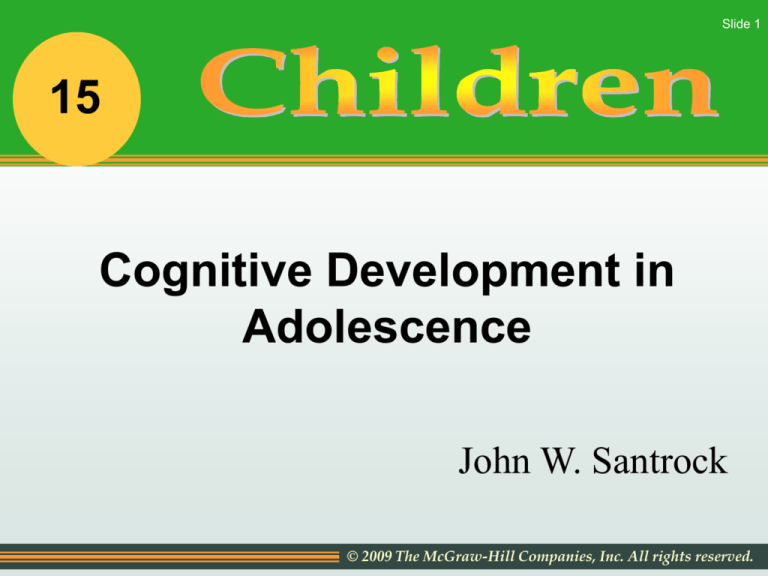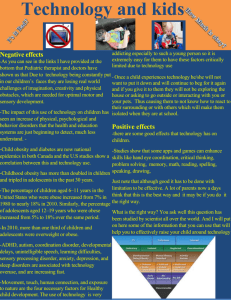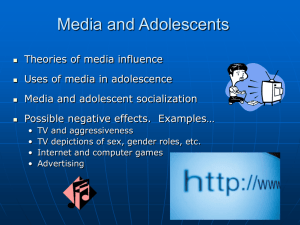
Slide 1
15
Cognitive Development in
Adolescence
John W. Santrock
© 2009 The McGraw-Hill Companies, Inc. All rights reserved.
Slide 2
Cognitive Development in
Adolescence
• How Do Adolescents Think and Process
Information?
• What Characterizes Adolescents’
Values, Moral Education, and Religion?
• What Are Schools for Adolescents Like?
• How Do Adolescents Experience Career
Development and Work?
© 2009 The McGraw-Hill Companies, Inc. All rights reserved.
How Do Adolescents Think and Process Information?
Slide 3
Piaget’s Theory
• Stage of formal operations
– Abstract thinking
– Idealism
– Hypothetical-deductive reasoning
• Develop and test hypotheses; deduce
best ways to solve problems
– Evaluating Piaget’s theory
© 2009 The McGraw-Hill Companies, Inc. All rights reserved.
How Do Adolescents Think and Process Information?
Slide 4
Adolescent Egocentrism
• Heightened self-consciousness
• Two types of social thinking
– Imaginary audience
• Believe others are as interested in them as they
are in themselves
– Personal fable
• Sense of personal uniqueness and invulnerability
© 2009 The McGraw-Hill Companies, Inc. All rights reserved.
How Do Adolescents Think and Process Information?
Slide 5
Information Processing
• Ability improves in adolescence
• Areas of improvement
– Memory
– Decision making
– Critical thinking
© 2009 The McGraw-Hill Companies, Inc. All rights reserved.
How Do Adolescents Think and Process Information?
Slide 6
Information Processing
• Memory
– Short-Term
• Improvements in problem solving
– Working
• Improves through early 20s
• Related to reading comprehension
– Long-Term
• Continues to improve in adolescence
© 2009 The McGraw-Hill Companies, Inc. All rights reserved.
How Do Adolescents Think and Process Information?
Slide 7
Information Processing
• Executive functioning
– Increased decision making
• Older adolescents better than younger
adolescents at decision making
• Adolescent decision making linked to some
personality traits
– Need opportunities to practice and discuss
realistic decision making
© 2009 The McGraw-Hill Companies, Inc. All rights reserved.
How Do Adolescents Think and Process Information?
Slide 8
Decision Making
• Critical thinking
– Adolescence is important
• Increased speed, automaticity, and capacity of
information processing
• Greater breadth of content knowledge
• Increased ability to construct new combinations
of knowledge
• Greater range and more spontaneous use of
strategies
© 2009 The McGraw-Hill Companies, Inc. All rights reserved.
What Characterizes Adolescents’ Values, Moral Education, and Religion?
Slide 9
Values
• Beliefs and attitudes about the way
things should be
– Changing values: more concern for
own well-being than service to others
• Self-fulfillment
• Self-expression
© 2009 The McGraw-Hill Companies, Inc. All rights reserved.
What Characterizes Adolescents’ Values, Moral Education, and Religion?
Slide 10
Values
• Changing values of adolescents
– Increased concern for personal well-being
– Some signs today’s college students shifting
to stronger interest in welfare of society
influenced by
• Family values, like compassion
• Group affiliation and goals or philosophies
© 2009 The McGraw-Hill Companies, Inc. All rights reserved.
What Characterizes Adolescents’ Values, Moral Education, and Religion?
Slide 11
Values
• Service learning
– Education promoting social responsibility
– Goals
• Adolescents become less self-centered
• Most effective when choice and opportunities to
reflect are given
• Volunteer characteristics: extraversion, high
degree of self-understanding, commitment to
others
© 2009 The McGraw-Hill Companies, Inc. All rights reserved.
What Characterizes Adolescents’ Values, Moral Education, and Religion?
Slide 12
Values
• Positive effects
– Better grades, more motivation and goals
– Deeper appreciation of ‘right’ behaviors
– Self-esteem improves
– Improved sense of making a difference
– Become less alienated
– More reflection on aspects of society
© 2009 The McGraw-Hill Companies, Inc. All rights reserved.
What Characterizes Adolescents’ Values, Moral Education, and Religion?
Slide 13
Moral Education
• Hidden curriculum
– From schools, create moral atmosphere
• Teachers as role models
• Attitudes of peers and others
• Rules/regulations and materials provided
• Character education
– Direct education approach; teaching
moral literacy to prevent harm, immorality
© 2009 The McGraw-Hill Companies, Inc. All rights reserved.
What Characterizes Adolescents’ Values, Moral Education, and Religion?
Slide 14
Moral Education
• Values clarification
– Encouraged to define own values,
understand values of others
– Different from character education: does
not tell student what values should be
• Cognitive moral education
– Democracy and justice valued as moral
reasoning develops
© 2009 The McGraw-Hill Companies, Inc. All rights reserved.
What Characterizes Adolescents’ Values, Moral Education, and Religion?
Slide 15
Moral Education
• Integrative approach encompasses
– Reflective moral thinking
– Commitment to justice
– Child Development Project
•
•
•
•
Many opportunities in perspective taking
Self-reflection on fairness, social responsibility
Adults coach ethical decision making
Caring community extended beyond classroom
© 2009 The McGraw-Hill Companies, Inc. All rights reserved.
What Characterizes Adolescents’ Values, Moral Education, and Religion?
Slide 16
Religion
• Issues important to adolescents
– Belief in God and prayer
– Learn religious faith
• Positive role in adolescent lives
– Becomes part of life, means of coping
– Better grades and school performance
– Impacts on health and behaviors
© 2009 The McGraw-Hill Companies, Inc. All rights reserved.
What Characterizes Adolescents’ Values, Moral Education, and Religion?
Slide 17
Religion
• Erikson’s Theory
– Adolescents grapple with religious
questions as part of search for identity
• Piaget: Stages of Religious Thought
– Preoperative intuitive: up to 7–8 years
– Concrete operational: 7–8 to 13–14
– Formal operational: 14 onward
© 2009 The McGraw-Hill Companies, Inc. All rights reserved.
What Characterizes Adolescents’ Values, Moral Education, and Religion?
Slide 18
Religion
• Religious Beliefs and Parenting
– Religion: created to socialize children
• Most adults adopt the religion raised in
• Affected by quality of parent-adolescent
relationship; securely attached more likely to
adopt parents’ choice
– Religious changes and reawakenings most
likely during adolescence
© 2009 The McGraw-Hill Companies, Inc. All rights reserved.
What Characterizes Adolescents’ Values, Moral Education, and Religion?
Slide 19
Religion
• Religion and Adolescent Sexuality
– Aspects of religiousness related to
• Selecting friends with restrictive attitudes
• Fewer sexual partners, relationships
• Perception of unprotected sex as high risk
• Responsible contraceptive use
© 2009 The McGraw-Hill Companies, Inc. All rights reserved.
What Are Schools for Adolescents Like?
Slide 20
The American Middle School
• Transition
– Can be stressful
– Occurs during time of many changes
• Puberty
• Cognitive development
• Changing relationship with parents
– Top-dog phenomenon
© 2009 The McGraw-Hill Companies, Inc. All rights reserved.
What Are Schools for Adolescents Like?
Slide 21
The American Middle School
• Effective Middle Schools
– Develop smaller schools
– Lower student-to-counselor ratios
– Involve parents and community leaders
– Develop effective curricula in literacy,
sciences, health, ethics, and citizenship
– Team-teaching in integrated curriculum
– More health and fitness programs
© 2009 The McGraw-Hill Companies, Inc. All rights reserved.
What Are Schools for Adolescents Like?
Slide 22
The American Middle School
• Extracurricular activities
– Involvement associated with
• Better academic adjustment
• Superior psychological competencies
• Positive peer relations
• Countering negative expenses
© 2009 The McGraw-Hill Companies, Inc. All rights reserved.
What Are Schools for Adolescents Like?
Slide 23
The American High School
• Many graduates poorly prepared for
college and modern workplace
– Recommended changes
• More emphasis on knowledge and skills
• Higher expectations for students
• Part-time work opportunities in high-quality
work experiences, shorter work hours
© 2009 The McGraw-Hill Companies, Inc. All rights reserved.
What Are Schools for Adolescents Like?
Slide 24
High School Dropouts
• Serious educational, societal problem
– Adults with educational deficiencies
– Affects economic and social well-being
– Overall rates declined in 21st century
– Native Americans may have highest rate;
Latino rate also remains high
– Males more likely to drop out than females
© 2009 The McGraw-Hill Companies, Inc. All rights reserved.
What Are Schools for Adolescents Like?
Slide 25
High School Dropouts
• Causes
– School-related
• Don’t like school; suspended, expelled
– Economic and family-related
• Low SES more to help support families
– Peer-related
– Personal reasons
• Pregnancy or marriage
© 2009 The McGraw-Hill Companies, Inc. All rights reserved.
What Are Schools for Adolescents Like?
Slide 26
High School Dropouts
• Reducing the Dropout Rate
– Provide effective programs in
• Early reading and tutoring
• Counseling and mentoring
– Create caring environment
– Offer community service opportunities
© 2009 The McGraw-Hill Companies, Inc. All rights reserved.
What Are Schools for Adolescents Like?
Slide 27
Career Development
• Ginzberg’s stages of development
career choice theory
– Fantasy: lasts to about age 11
– Tentative: from ages 11 to 17
– Realistic: from ages 17 to 18
• Criticisms of theory
– Ignores individual differences
© 2009 The McGraw-Hill Companies, Inc. All rights reserved.
What Are Schools for Adolescents Like?
Slide 28
Career Development
• Super’s Career Self-Concept Theory
– Self-concepts play central roles in
choices; constructed during
adolescence
– Occurs in five phases
© 2009 The McGraw-Hill Companies, Inc. All rights reserved.
What Are Schools for Adolescents Like?
Slide 29
Career Development
Stage
Age
Description
Crystallization
14-18 Develop ideas about work with
existing global self-concept
Specification
18-22 Choices narrow; initiates behavior
to enter some career
Implementation 21-24 Complete education or training;
enter world of work
Stabilization 25-35 Decide specific/appropriate career
Consolidation
35+ Seek advancement, high status
© 2009 The McGraw-Hill Companies, Inc. All rights reserved.
What Are Schools for Adolescents Like?
Slide 30
Career Development
• Holland’s Personality-Type theory
– Make effort to match individual to career
– Matching personality to career promotes:
• Happiness in job
• Longevity in workplace
– Six main personality types
© 2009 The McGraw-Hill Companies, Inc. All rights reserved.
What Are Schools for Adolescents Like?
Slide 31
Career Development
Personality
Realistic
Career
“masculine” traits; construction, labor,
truck driving, or farming
Intellectual “thinkers”; math and science careers
Social
“feminine” traits; teaching, social work, or
counseling
Conventional Structure: bank teller, clerk, secretary
Enterprising “verbal” and dominating; politics, sales, or
management
Artistic
“expressive”; art and writing
© 2009 The McGraw-Hill Companies, Inc. All rights reserved.
What Are Schools for Adolescents Like?
Slide 32
Career Development
• Exploration, Decision Making, Planning
– Important roles in adolescents’ choices
• Approached with ambiguity, uncertainty, and
stress
– Many adolescents
• Receive little direction from school guidance
counselors
• Do not know what information to seek and how
to seek it
© 2009 The McGraw-Hill Companies, Inc. All rights reserved.
What Are Schools for Adolescents Like?
Slide 33
Career Development
• Sociocultural Influences
– Genetic limitations
– Parents and peers
– School
– Socioeconomic status
– Ethnicity
– Gender
© 2009 The McGraw-Hill Companies, Inc. All rights reserved.
How Do Adolescents Experience Career Development and Work?
Slide 34
Work
• Sociocultural context of work
– Three-fourths of high school seniors have
had work experience
– Most work 16 to 20 hours per week
– Most work in service jobs
– Males work longer hours and are paid
more per hour than females
© 2009 The McGraw-Hill Companies, Inc. All rights reserved.
How Do Adolescents Experience Career Development and Work?
Slide 35
Advantages and Disadvantages
of Part-Time Work
Pros
Cons
– Understand how
business world works
– Learn how to get and
keep a job
– Manage money
– Budget time
– Take pride in their
accomplishments
– Evaluate goals
– Little on-job training;
distanced to adult
coworkers
– Give up sports
– Miss sleep, social
affairs with friends
– More stress to life
– Lower grades
© 2009 The McGraw-Hill Companies, Inc. All rights reserved.
How Do Adolescents Experience Career Development and Work?
Slide 36
Work Profiles of Adolescents
Around the World
• Many developing countries
– Adolescents do not attend school
– Boys earn more income than girls
– Girls do more unpaid labor than boys
– Unschooled populations: labor exceeds
8 hours per day
– European and East Asian adolescents
work much less than U.S. adolescents
© 2009 The McGraw-Hill Companies, Inc. All rights reserved.
Slide 37
15
The End
© 2009 The McGraw-Hill Companies, Inc. All rights reserved.





